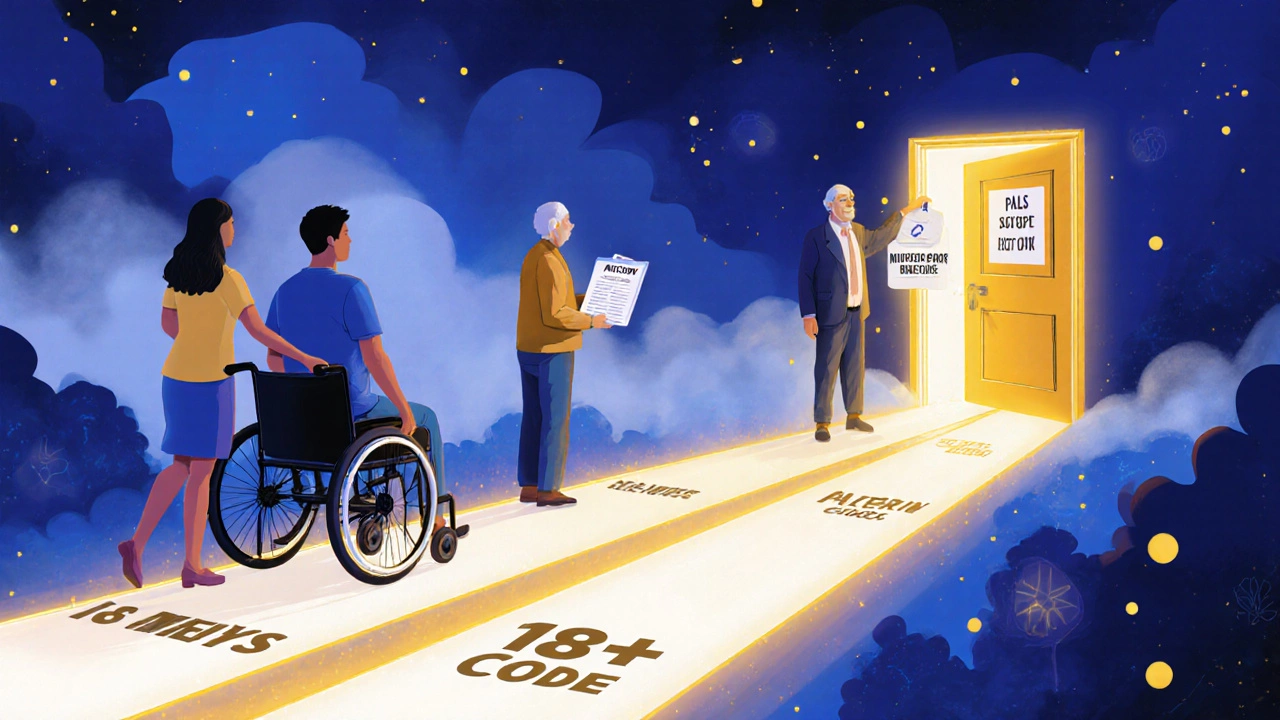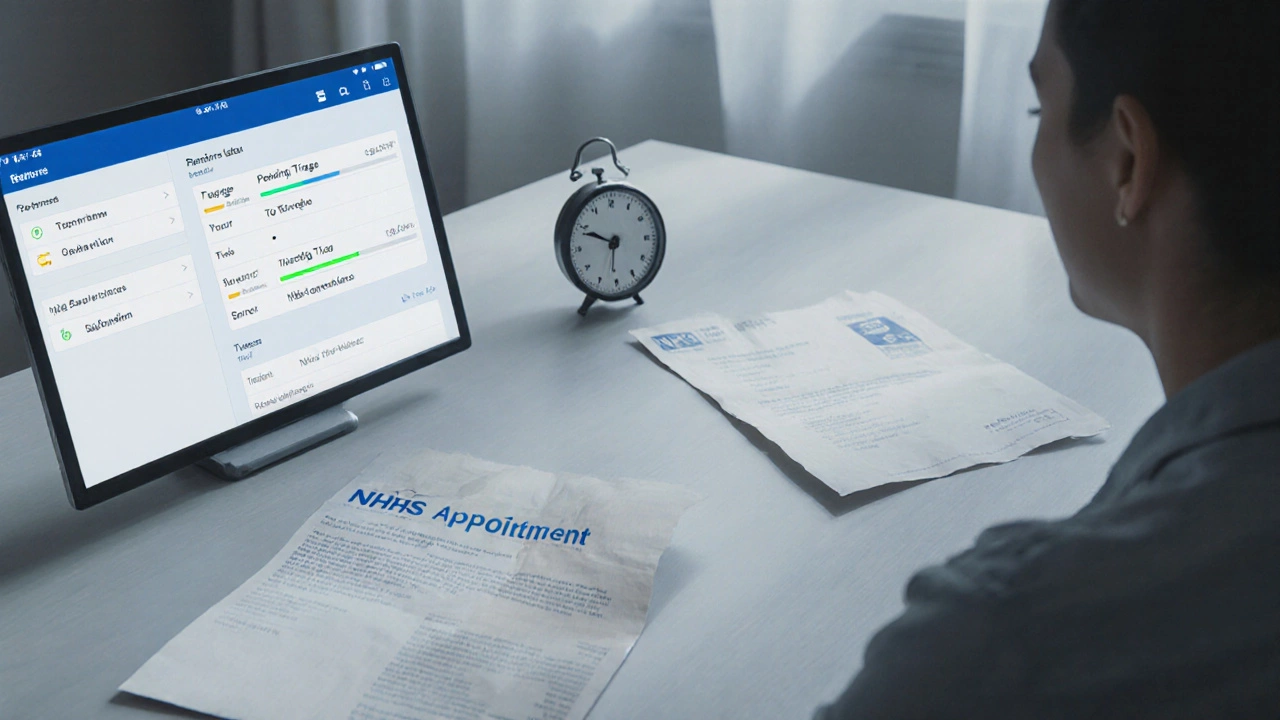If you’ve just been referred by your GP or sent for a test, you’re probably staring at your phone, wondering when you’ll hear back from the NHS. It’s a common worry - and the truth is, there’s no single answer. How long you wait depends on what you’re waiting for, where you live, how busy the system is, and whether your case is urgent. But you don’t have to guess. Here’s what actually happens after you’re referred, and what you can do to speed things up.
What happens after your GP refers you?
When your GP refers you to a hospital specialist, they send an electronic request. That’s not the same as booking an appointment. The referral lands in a triage team’s inbox - often staffed by nurses or administrative staff who sort cases by urgency. If you have symptoms like chest pain, sudden vision loss, or unexplained weight loss, your referral gets flagged as urgent. These cases are usually seen within two weeks. But if your issue is something like mild back pain or a slow-growing lump, you’ll be placed in the routine queue.
The NHS doesn’t send you a confirmation email or text. You’ll get a letter - sometimes by post, sometimes by email if you’ve signed up for digital notifications. That letter might come in 3 days. Or it might take 6 weeks. There’s no rule. And that’s frustrating because you’re left in the dark.
Typical waiting times by service
Waiting times vary wildly depending on the type of care you need. Here’s what recent data shows for England (as of early 2025):
- Urgent referrals (suspected cancer): 95% of patients seen within 2 weeks. This is a legal target, and most trusts meet it.
- Non-urgent specialist appointments: Average wait is 12-18 weeks. Some areas, like parts of the North East and Wales, are hitting 20+ weeks.
- Diagnostic scans (MRI, CT): 6-10 weeks for routine scans. If you’re on a waiting list for an MRI for back pain, you’re likely in this group.
- Elective surgery (hip/knee replacement): Average wait is 26 weeks. Some hospitals have backlogs stretching to 40 weeks.
- Psychological therapy (IAPT): 6-12 weeks for first appointment. In cities like Manchester or Birmingham, waits can be longer.
These aren’t guesses. They’re based on NHS Digital’s quarterly reports. But numbers don’t tell the whole story. A 12-week wait in London might mean you’re seen in 8. In rural Cumbria, it could mean 16. Location matters.
Why the delays? It’s not just staff shortages
People blame staff shortages. And yes, there aren’t enough consultants, radiographers, or nurses. But that’s only part of the problem. The bigger issue is how referrals are handled.
Many hospitals still rely on paper-based systems or outdated software. A single referral can get stuck in limbo if the GP’s form is incomplete - missing a blood test result, a patient ID, or the right code. One hospital in Sheffield told me they reject 1 in 5 referrals just because the paperwork’s wrong. That means you’re not just waiting for an appointment - you’re waiting for someone to notice your file is broken.
And then there’s the triage bottleneck. A single triage nurse might handle 300 referrals a week. They can’t possibly read each one in depth. So they use algorithms. If your symptom matches a low-risk pattern, you’re bumped to the bottom. Even if you’re in pain. Even if you’re scared.

What you can do to get seen faster
You can’t control the system. But you can control how you interact with it.
- Ask your GP for the referral code. Every referral has a unique number. Write it down. If you haven’t heard back in 4 weeks, call the hospital’s appointments line and give them the code. Most won’t ask for it - but if you do, you’ll get a real answer.
- Check your NHS account online. If you’ve registered for NHS login, you can see your referral status. It won’t say ‘your appointment is booked’ - but it will show if your referral has been received, triaged, or is pending.
- Don’t wait for the letter. If you’re worried, call the hospital directly. Don’t ask, ‘When will I hear back?’ Ask, ‘Is my referral [insert code] still pending?’ That’s a specific question. They can answer it.
- Update your GP if your symptoms change. If your pain gets worse, you start losing weight, or you feel dizzy - tell your GP. They can upgrade your referral to urgent. That moves you to the front of the line.
- Use NHS 111 if you’re deteriorating. If you’re in pain and can’t wait, call 111. They can fast-track you to urgent care, even if you’re not in A&E.
What counts as an emergency?
Not every bad symptom means you need A&E. But some things can’t wait. If you have:
- Sudden, severe chest pain or pressure
- Difficulty breathing or gasping for air
- Loss of vision or sudden double vision
- Weakness on one side of your body
- Unexplained bleeding or a lump that’s growing fast
- don’t wait for a referral. Go to A&E or call 999. These are red flags. The NHS will prioritize you.

What if you’re still waiting after 18 weeks?
By law, you have the right to be seen within 18 weeks for non-urgent care. If you’ve waited longer, you can request an alternative provider. That means the NHS has to find you a spot at a different hospital - even a private one - and pay for it.
You don’t need a lawyer. You don’t need to complain loudly. Just call the NHS Patient Advice and Liaison Service (PALS). They’ll help you request a referral to another provider. It’s not a guarantee you’ll get seen faster - but it’s your legal right, and most trusts will act on it.
Is there a better way?
Some areas are testing new systems. In Kent, they’ve started using AI to sort referrals. It flags high-risk cases automatically and sends low-risk ones to community physiotherapists instead of hospital specialists. In one pilot, 40% of back pain referrals were handled without ever seeing a doctor - and patients were happier.
That’s the future: less waiting, more smart triage. But it’s not everywhere yet. For now, the system is still slow. And the only way to beat it is to be persistent, informed, and proactive.
What to do right now
If you’re waiting:
- Write down your referral date and code.
- Check your NHS app or website every 7-10 days.
- Call the hospital if it’s been over 4 weeks.
- Update your GP if anything changes.
- Don’t assume silence means nothing’s happening. It just means you need to ask.
The NHS isn’t broken. It’s overwhelmed. And you’re not alone in waiting. But you don’t have to sit still. Take control. Ask. Follow up. Push gently. That’s how you get seen.
How long does it take to get an NHS appointment after a GP referral?
There’s no fixed time. Urgent referrals (like suspected cancer) are seen within 2 weeks. Non-urgent appointments, like for back pain or joint issues, typically take 12-18 weeks - but can be longer depending on location and hospital capacity. Always check your NHS online account or call the hospital with your referral code to get an update.
Can I speed up my NHS referral?
Yes. First, make sure your GP’s referral form is complete. Then, if your symptoms worsen - like increased pain, weight loss, or new symptoms - contact your GP again and ask them to upgrade your referral to urgent. You can also call the hospital directly with your referral code after 4 weeks to check its status. Don’t wait for a letter - take action.
What should I do if I’ve waited over 18 weeks?
You have a legal right to be seen within 18 weeks for non-urgent care. If you’ve waited longer, contact the NHS Patient Advice and Liaison Service (PALS). They can help you request a referral to an alternative provider - even a private hospital - that the NHS will pay for. This doesn’t guarantee a faster appointment, but it’s your right and often leads to action.
Do I get notified when my NHS referral is received?
No. The NHS doesn’t send automatic notifications. You’ll usually get a letter in the post - or an email if you’ve signed up for digital alerts. But many people miss this. Check your NHS online account for your referral status. If you haven’t heard anything after 2-3 weeks, call the hospital with your referral code to confirm it was received.
Is it worth calling the hospital directly?
Absolutely. Most people wait for a letter and never follow up. But hospital staff can look up your referral by its unique code. Calling after 4 weeks gives you real information: Is it pending? Triaged? Booked? You’ll get a clearer answer than any online tracker. Don’t be shy - it’s your health.
What’s the difference between urgent and routine referrals?
Urgent referrals are for conditions that could be serious - like unexplained lumps, sudden neurological symptoms, or suspected cancer. These are legally required to be seen within 2 weeks. Routine referrals are for less urgent issues - like mild joint pain, slow-progressing conditions, or routine follow-ups. These go into a longer queue and can take months. Your GP decides the category, but you can ask them to review it if your symptoms change.




